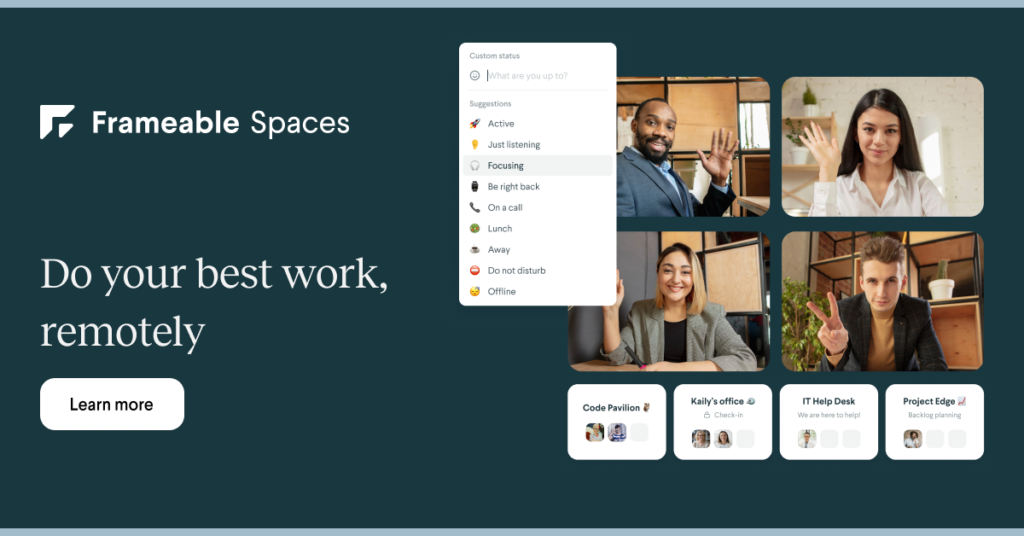Is your team ready to transition to the hybrid future of work? If you haven’t documented and shared your hybrid work plan yet, it’s not.
The latest employee and employer survey data shows that most teams will introduce a hybrid working model once COVID restrictions are lifted, with a smaller percentage of companies planning for a primarily in-person workforce.
Despite the enthusiasm of many U.S. companies to return to the office this fall, growing concerns around the COVID-19 Delta variant (and any future variants) may postpone many team’s plans, as is the case for Apple.
Although it’s not clear when most teams will be able to resume office-based work safely, now is the ideal time to explore your team’s concerns about the future of work and partner with them to develop your hybrid work plan. We share five ways to get started.
5 Steps to Draft a Hybrid Work Plan for Your Flexible Workforce
Charting your team’s return to the office may feel like an impossible task, given the ever-evolving set of challenges and considerations your teams face. But if you solicit executive and employee insights to guide your planning, your team will be more forgiving of any missteps or hurdles along the way.
These five steps will get your team started in building its hybrid work culture, including how to address your team’s needs throughout this process.
1. Survey Your Team
Kickstart your hybrid work planning by surveying your team members to understand their expectations for the future of work. Use a mix of qualitative and quantitative questions in your survey, and supplement these findings with one-on-one conversations to drill further into specifics.
Preface all surveys and conversations with an explanation of how your team will use the information. Reinforce that you welcome all ideas as you will need your team’s honest feedback to best structure your team’s future work policy.
You need as complete a picture as possible of your employees’ current challenges with remote work. Your surveys and conversations should explore all of the following areas for your team members:
- Preferences for how many days a week they work in-office, if any
- What type of work or activities do they feel is best conducted in the office
- Personal circumstances that may affect their ability to work during certain business hours
- Whether they need more or different tools or resources to complete their work
- If the team’s current success metrics align to support a healthy and productive work culture
2. Adapt Your Physical Space for Virtual and Distanced In-Person Collaboration
A recent PwC report found that only 13% of executives are prepared to permanently let go of their company’s physical workspace. But that doesn’t mean the office should stay exactly as it was.
Use your team survey feedback to assess what activities will be most common in your physical office. For example, do team members want an open layout for easy mixing and mingling? An array of small, private meeting rooms for someone to take a quick call? Socially distanced personal workspaces?
Once you have a sense of how many team members may be in your office at any given time, create new solo work and collaboration spaces that can accommodate the average number of employees. Consider implementing a desk hoteling strategy to optimize your layout further. It’s also essential to optimize your physical office space for hybrid work, not just for those who return to the office. And don’t forget to give shared spaces the technology they need to integrate into your virtual team spaces.
3. Reset Your Workplace KPIs to Reflect New Hybrid Work Norms
The shift to remote-based work forced teams to assess how to support a healthy and productive working culture. For most teams, this meant a thorough look at the team’s workflow and collaboration tools, common communications practices, and other traditionally unquestioned aspects of the team’s work.
Now, teams should review whether their markers of success align with what actually drives business value. According to a Citrix survey, 86% of employees said they would prefer to work for a company that prioritizes outcomes over output, meaning they want to be measured by the impact they can deliver to the entire business, not just their direct work output.
In your employee surveys and conversations, ask your team if they feel the key performance indicators (KPIs) they are measured against accurately reflect the value of their work, and assess if a different KPI is more appropriate. Review your list of new proposed KPIs, and ensure that your team can accurately track each KPI, or if you’ll need to adopt a new practice or tool to do so.
4. Support Your Hybrid Work Plan with Digital Communications Guidelines
Communications guidelines are a vital aspect of a healthy hybrid working culture that most teams often overlook. Many teams adopted new virtual collaboration tools during the pandemic, but it’s essential to take this one step further and document what team members should use each tool to accomplish.
Some team members may overuse their virtual communications channels, possibly because they are used to getting quick face-to-face feedback in an office environment. Create guidelines that discuss which channels should be used for workplace communications, do’s and don’ts for using these channels, and general guidelines that explain how your team can preserve a healthy working culture online.
You can start building your workplace communication policy guidelines based on these samples from Cutting Edge and JotForm.
5. Over-Communicate About Your Hybrid Work Policy
It is understandable for leadership teams to wait until their hybrid work planning is underway or the hybrid work policy is close to final before communicating these plans with the team. However, this may not be the right approach for today’s environment.
A McKinsey survey found that nearly half of workers feel that a lack of clear vision about the future of work from their employer is causing them concern or anxiety. To address this, create a regular communications cadence to keep your team updated on your team’s planning, and regularly invite questions or create open space to discuss these plans.
Start with your employee surveys. After the initial fielding and analysis, share high-level findings in a team email, and host an optional meeting to further drill into the feedback. Update your team at least once a month on any progress your team has made and upcoming opportunities to learn more. Finally, host an optional meeting each month for employees to ask questions about the future of work and for the leadership team to gauge the early sentiment towards their plans.
If appropriate, your team can create a hybrid work planning committee composed of cross-department team members of various levels. This committee will partner with your executive and HR team to assist in various planning discussions and represent each department or team.
Remember, it’s better to keep your team in the loop on your plans and invite their feedback earlier on. Otherwise, you may unveil a hybrid work policy that fails to meet your team’s needs and amplifies their feelings of stress or anxiety.
Once your initial hybrid work policy is created, and you inform the team of your plans, continue reviewing and adjusting your policy as new concerns emerge.
To further support your hybrid work future, learn how Frameable’s suite of team collaboration and social connection tools can help increase your team’s productivity and provide data that can help you get ahead of potential workplace culture issues.










